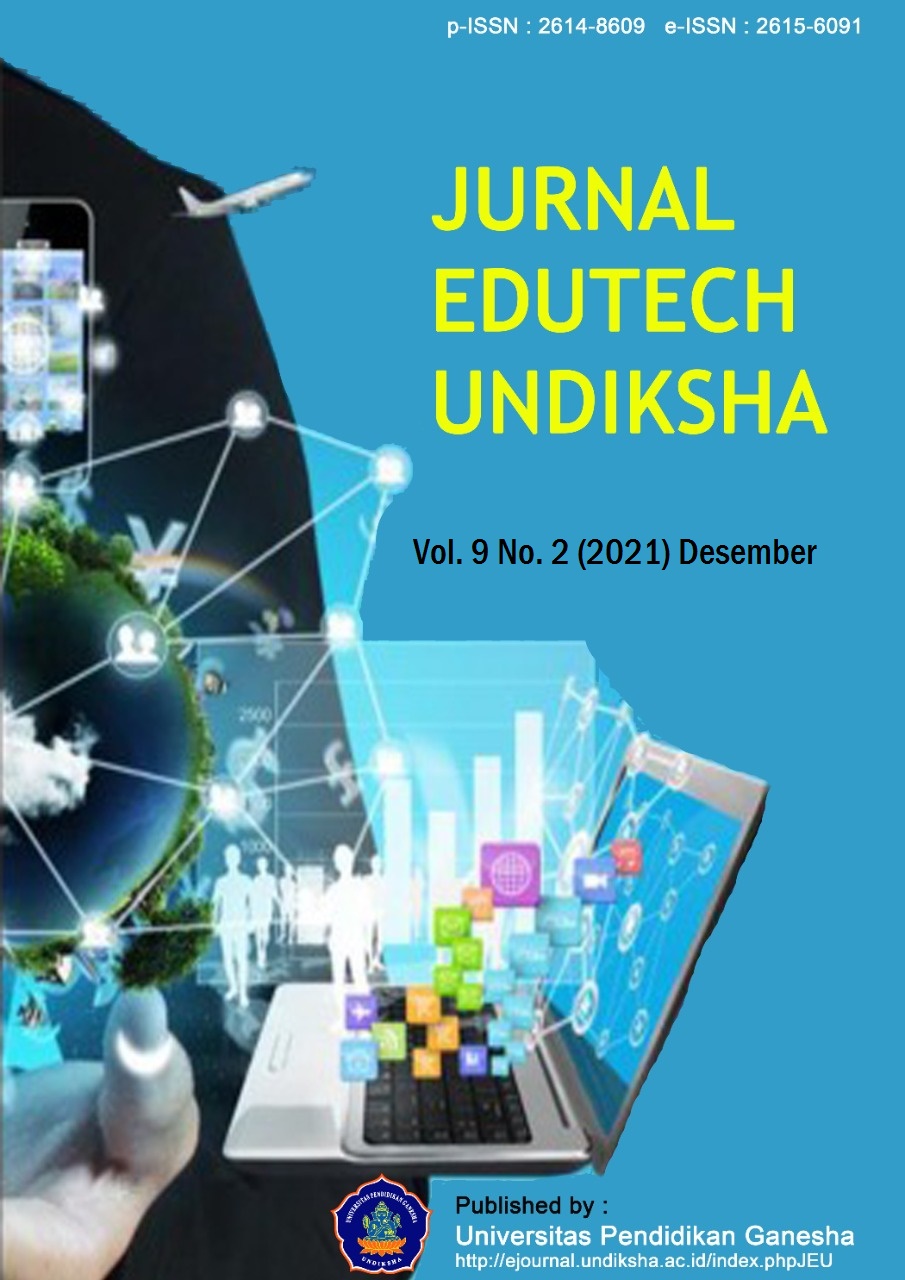Evaluasi Layanan Bimbingan Teknologi Informasi dan Komunikasi (TIK)
DOI:
https://doi.org/10.23887/jeu.v9i2.38949Keywords:
Evaluasi, Bimbingan, TIKAbstract
Pelaksanaan layanan TIK belum maksimal. Beberapa sekolah belum memiliki fasilitas penunjang untuk melaksanakan layanan bimbingan TIK seperti masih kurangnya perangkat komputer di sekolah dan tidak adanya akses internet. Hal ini mengakibatkan kurangnya pemahaman dan pemanfaatan teknologi pada peserta didik. Penelitian ini bertujuan untuk mengevaluasi pelaksanaan layanan bimbingan TIK pada siswa. Layanan bimbingan TIK yang dilakukan di sekolah dimaksudkan untuk mempersiapkan peserta didik agar mampu mengantisipasi pesatnya perkembangan teknologi, sehingga peserta didik dapat memanfaatkan TIK dengan baik dan benar sesuai dengan keahliannya. Penelitian ini adalah penelitian evaluasi dengan pendekatan kuantitatif menggunakan model penelitian evaluasi Kirkpatrick dengan empat level tahapan evaluasi, yaitu level reaksi, pembelajaran, perilaku, dan hasil. Subjek pada penelitian ini adalah peserta didik yang sedang mengikuti layanan bimbingan TIK. Teknik pengambilan data melalui kuesioner/angket. Hasil analisis data menunjukkan bahwa ketercapaian layanan bimbingan TIK pada komponen level 1 reaksi sebesar 71,46% dengan kategori baik, komponen level 2 pembelajaran sebesar 74,41% dengan kategori baik, komponen level 3 perilaku sebesar 72% dengan kategori baik, dan komponen level 4 hasil sebesar 74,73% dengan kategori baik. Dengan demikian dapat disimpulkan bahwa layanan bimbingan TIK pada peserta didik dikategorikan baik pada semua variabel pengukuran.
References
Almusawi, H. A., Durugbo, C. M., & Bugawa, A. M. (2021). Innovation in Physical Education: Teachers’ pPrspectives on Readiness for Wearable Technology Integration. Computers & Education, 167. https://doi.org/10.1016/j.compedu.2021.104185.
Almutairi, T. S., & Shraid, N. S. (2021). Teacher Evaluation by Different Internal Evaluators: Head of Departments, Teachers Themselves, Peers and Students. International Journal of Evaluation and Research in Education, 10(2), 588–596. https://doi.org/10.11591/ijere.v10i2.20838.
Amelia, R. P., Filiani, R., & Herdi, H. (2017). Self-Efficacy terhadap Penggunaan Teknologi Informasi dan Komunikasi dalam Layanan Bimbingan dan Konseling pada Guru Bk/Konselor SMAN Jakarta Pusat. Insight: Jurnal Bimbingan Dan Konseling, 3(1). https://doi.org/10.21009/INSIGHT.031.18.
Andrian, & Rusman. (2019). Implementasi Pembelajaran Abad 21 dalam Kurikulum 2013. Jurnal Penelitian Ilmu Pendidikan, 12(1). https://doi.org/10.21831/jpipfip.v12i1.20116. 14-23.
Astiningtyas, A. (2018). Kesiapan Guru Sekolah Dasar dalam Pelaksanaan Pembelajaran Tematik Integratif pada Kurikulum 2013. Primary: Jurnal Pendidikan Guru Sekolah Dasar, 7(1), 60. https://doi.org/10.33578/jpfkip.v7i1.5340.
Bal-Taştan, S., Davoudi, S. M. M., Masalimova, A. R., Bersanov, A. S., Kurbanov, R. A., Boiarchuk, A. V, & Pavlushin, A. A. (2018). The Impacts of Teacher’s Efficacy and Motivation on Student’s Academic Achievement in Science Education among Secondary and High School Students. EURASIA Journal of Mathematics, Science and Technology Education, 14(6), 2353–2366. https://doi.org/10.29333/ejmste/89579.
Bdiwi, R., de Runz, C., Faiz, S., & Cherif, A. A. (2019). Smart learning environment: Teacher’s role in assessing classroom attention. Research in Learning Technology, 27, 1–14. https://doi.org/10.25304/rlt.v27.2072.
Bervell, B., Nyagorme, P., & Arkorful, V. (2020). LMS-Enabled Blended Learning Use Intentions among Distance Education Tutors: Examining the Mediation Role of Attitude Based on Technology-Related Stimulus-Response Theoretical Framework (TR-SR-TF). Contemporary Educational Technology, 12(2), ep273. https://doi.org/10.30935/cedtech/8317.
Bhatia, M., Stewart, A. E., Wallace, A., Kumar, A., & Malhotra, A. (2021). Evaluation of an In-Situ Neonatal Resuscitation Simulation Program Using the New World Kirkpatrick Model. Clinical Simulation in Nursing, 50. https://doi.org/10.1016/j.ecns.2020.09.006.
Bijani, M., Rostami, K., Momennasab, M., & Yektatalab, S. (2018). Evaluating the Effectiveness of a Continuing Education Program for Prevention of Occupational Exposure to Needle Stick Injuries in Nursing Staff Based on Kirkpatrick’s Model. Journal of the National Medical Association, 110(5). https://doi.org/10.1016/j.jnma.2017.11.002.
Buriak, S. E., & Ayars, C. L. (2019). Evaluation of a Drug and Alcohol Safety Education Program in Aviation using InterruptedTtime Series and the Kirkpatrick Framework. Evaluation and Program Planning, 73. https://doi.org/10.1016/j.evalprogplan.2018.11.003.
Darimi, I. (2017). Teknologi Informasi dan KomunikasisSebagai Media Pembelajaran Pendidikan Agama Islam Efektif. Jurnal Pendidikan Teknologi Informasi, 1(2), 111–121. https://doi.org/10.1007/s11068-008-9037-4.
Enas Almanasreh, E., Moles, R., & Timothy, M. (2019). Evaluation of Methods Used for Estimating Content Validity. Research in Social and Administrative Pharmacy, 15(2), 214–221. https://doi.org/10.1016/j.sapharm.2018.03.066.
Eugenia, Raymond, & Leung, W. N. (2013). Ready for 21st-Century Education – Pre-Service Music Teachers Embracing ICT to Foster Student-Centered Learning. Procedia - Social and Behavioral Sciences, 73. https://doi.org/10.1016/j.sbspro.2013.02.047.
Farjad, S. (2012). The Evaluation Effectiveness of Training Courses in University by Kirkpatrick Model (Case Study: Islamshahr University). Procedia - Social and Behavioral Sciences, 46. https://doi.org/10.1016/j.sbspro.2012.05.573.
Febriyanti. (2013). Article Kurikulum Pendidikan Tinggi di Era Globalisasi (Pergeseran dari Kurikulum Inti dan Institusional ke Kurikulum Berbasis Kompetensi). Ta’di Jurnal Pendidikan Islam, 18(2). https://doi.org/10.19109/tjie.v18i02.51.
Gozali, A. (2020). Bimbingan dan Konseling Berbasis Teknologi Informasi pada Masa PSBB ( Pembatasan Sosial Berskala Besar ). Jurnal Bimbingan Konseling Pendidikan Islam Coution : Journal of Counseling and Education Layanan, 1(2), 36–49. https://doi.org/10.47453/coution.v1i2.117.
Gracieux, F. Y. (2019). The Asian Sarcoma Consortium Sarcoma Preceptorship Program: A Program Evaluation Study Utilizing the Kirkpatrick Model (Level 1 and 2). Annals of Oncology, 30(9). https://doi.org/10.1093/annonc/mdz433.005.
Hanifa, R. (2018). EFL Published Materials: An Evaluation of English Textbooks for Junior High School in Indonesia. Advances in Language and Literary Studies, 9(2), 166. https://doi.org/10.7575/aiac.alls.v.9n.2p.166.
Harliawan, H. (2015). Penggunaan Media Pembelajaran Berbasis TIK untuk Meningkatkan Hasil Belajar IPS Kelas VIII J SMP Negeri 5 Singaraja. Ekuitas, 3(1). https://doi.org/10.23887/ekuitas.v3i1.12786.
Hashim, H. (2018). Application of Technology in the Digital Era Education. International Journal of Research in Counseling and Education, 1(2), 1. https://doi.org/10.24036/002za0002.
Huda, I. A. (2020). Perkembangan Teknologi Informasi dan Komunikasi ( TIK ) terhadap Kualitas Pembelajaran di Sekolah Dasar. Huda, Irkham Abdaul, 1(2), 143–149. https://doi.org/10.31004/jpdk.v1i2.622.
Hussein, B. R., Malik, O. A., Ong, W.-H., & Slik, J. W. F. (2021). Reconstruction of Damaged Herbarium Leaves Using Deep Learning Techniques for Improving Classification Accuracy. Ecological Informatics, 61. https://doi.org/10.1016/j.ecoinf.2021.101243.
Jang, M., Aavakare, M., Nikou, S., & Kim, S. (2021). The Impact of Literacy on Intention to Use Digital Technology for Learning: A Comparative Study of Korea and Finland. Telecommunications Policy, 45(7). https://doi.org/10.1016/j.telpol.2021.102154.
Li, J., Zhang, X., & Hu, Z. (2018). The Design and Application of Flip Classroom Teaching Based on Computer Technology. International Journal of Emerging Technologies in Learning, 13(10), 95–107. https://doi.org/10.3991/ijet.v13i10.9453.
Lubis, A. H. (2018). Integrasi TIK dalam Pengajaran Bahasa Inggris di Indonesia Abad Ke-21: Mitos dan Realita. Cakrawala Pendidikan, 37(1), 11–21. https://journal.uny.ac.id/index.php/cp/article/view/16738/pdf.
Maharani, Y. S. (2015). Efektivitas Multimedia Pembelajaran Interaktif Berbasis Kurikulum 2013. Indonesian Journal of Curriculum and Educational Technology Studies, 3(1), 31–40. https://doi.org/10.15294/ijcets.v3i1.8683.
Mellom, P. J., Straubhaar, R., Balderas, C., Ariail, M., & Portes, P. R. (2018). “They Come with Nothing:” How Professional Development in a Culturally Responsive Pedagogy Shapes Teacher Attitudes towards Latino/a English Language Learners. Teaching and Teacher Education, 71, 98–107. https://doi.org/10.1016/j.tate.2017.12.013.
Mulyadin. (2016). Implementasi Kebijakan Pembelajaran Tematik Terpadu Kurikulum 2013 di SDN Kauman 1 Malang dan SD Muhammadiyah 1 Malang. Jurnal Pendidikan Edutama, 3(2), 31–48. https://doi.org/http://dx.doi.org/10.30734/jpe.v3i2.35.
Mulyanto, B. S., Sadono, T., Koeswanti, H. D., Dasar, S., Wonodoyo, N., Tengah, J., Kristen, U., Wacana, S., & Tengah, J. (2020). Evaluation of Critical Thinking Ability with Discovery Lerning Using Blended Learning Approach in Primary School. Journal of Educational Research and Evaluation, 9(2), 78–84. https://doi.org/10.15294/jere.v9i2.46135.
Muyaroah, & Fajartia. (2017). Pengembangan Media Pembelajaran Berbasis Android dengan Menggunakan Aplikasi Adobe Flash CS 6 pada Mata Pelajaran Biologi. Innovative Journal of Curriculum and Educational Technology., 6(2). https://doi.org/10.15294/ijcet.v6i2.19336.
Nasihin, S. (2016). Implementasi Kurikulum 2013 di MTs Yaqin 1 Kwang Rundun Kecamatan Jerowaru (Masalah dan Solusinya). Jurnal Studi Keislaman Dan Ilmu Pendidikan, 4(1), 56–86. https://doi.org/10.36088/palapa.v4i1.8.
Pennings, H. J. M., Brekelmans, M., Sadler, P., Claessens, L. C. A., van der Want, A. C., & van Tartwijk, J. (2018). Interpersonal Adaptation in Teacher-Student Interaction. Learning and Instruction, 55, 41–57. https://doi.org/10.1016/j.learninstruc.2017.09.005.
Peralbo-Uzquiano, M., Fernández-Abella, R., Durán-Bouza, M., José-Manuel Cotos-YáñezBrenlla-Blanco, J.-C., & Brenlla-Blanco, J.-C. (2020). Evaluation of the Effects of a Virtual Intervention Programme on Cognitive Flexibility, Inhibitory Control and Basic Math Skills in Childhood Wducation. Computers & Education, 159. https://doi.org/10.1016/j.compedu.2020.104006.
Rahmawati, Budiyono, & Wardi. (2017). Pengembangan Modul Pembelajaran Digital Berbasis Visual Basic for Application (VBA) PowerPoint. Indonesian Journal of Curriculum and Educational Technology, 5(1). https://doi.org/https://doi.org/10.15294/ijcets.v5i1.14248.
Riansyah, H., & Wulandari, W. (2017). Layanan Bimbingan Kelompok dalam Meningkatkan Interaksi Sosial Siswa. Teraputik: Jurnal Bimbingan Dan Konseling, 1(1). https://doi.org/10.26539/1110.
Sakthi, T., & Moshi, A. A. M. (2021). Effectiveness Measurement Study on Entrepreneurship Awareness Camp for Technical Education Students Using Kirkpatrick’s Model. Materials Today: Proceedings, 45(2). https://doi.org/10.1016/j.matpr.2020.08.419.
Sanjiwana, Pudjawan, & Margunayasa. (2015). Analisis Sikap Sosial Siswa Kelas V pada Pembelajaran dengan Kurikulum 2013. Jurnal PGSD Universitas Pendidikan Ganesha Jurusan PGSD, 3(1), 11–18. https://doi.org/10.23887/jjpgsd.v3i1.5631.
Savul, S., Ikram, A., Khan, M. A., & Khan, M. A. (2021). Evaluation Of Infection Prevention and Control Training Workshops Using Kirkpatrick’s Model. International Journal of Infectious Diseases, 1. https://doi.org/10.1016/j.ijid.2021.09.005.
Susanti, N. Y., Trapsilasiwi, D., & Kurniati, D. (2015). Analisis Tingkat Kognitif Uji Kompetensi pada Buku Sekolah Elektronik (BSE) Matematika SMP/MTs Kelas VII Kurikulum 2013 Berdasarkan Taksonomi Bloom. Kreano Jurnal Matematika Kreatif-Inovatif, 6(1). https://doi.org/10.15294/kreano.v6i1.4509.
Tanudjaya, C. P., & Doorman, M. (2020). Examining Higher Order Thinking in Indonesian Lower Secondary Mathematics Classrooms. Journal on Mathematics Education, 11(2), 277–300. https://doi.org/10.22342/jme.11.2.11000.277-300.
Tempelaar, D. (2019). Assessment & Evaluation in Higher Education Supporting the Less-Adaptive Student: The Role of Learning Analytics, Formative Assessment and Blended lLarning. Assessment and Evaluation in Higher Education, 45(4). https://doi.org/10.1080/02602938.2019.1677855.
Todorescu, L., Popescu-mitroi, M., & Greculescu, A. (2015). Students ’ Views on the Teacher as An Information Provider Students ’ Views on the Teacher as An Information Provider. Procedia - Social and Behavioral Sciences, 197(November), 184–189. https://doi.org/10.1016/j.sbspro.2015.07.121.
Tseng, S. (2021). The Influence of Teacher Annotations on Student Learning Engagement and Video Watching Behaviors. International Journal of Educational Technology in Higher Education, 18(1), 1–17. https://doi.org/10.1186/s41239-021-00242-5.
Tuma, F. (2021). The Use of Educational Technology for Interactive Teaching in Lectures. Annals of Medicine and Surgery 62, 231–235. https://doi.org/10.1016/j.amsu.2021.01.051.
Wu, W. H., Kao, H. Y., Wu, S. H., & Wei, C. W. (2019). Development and Evaluation of Affective Domain Using Student’s Feedback in Entrepreneurial Massive Open Online Courses. Frontiers in Psychology, 10(MAY). https://doi.org/10.3389/fpsyg.2019.01109.
Yongliang, T., Hu, L., Jiao, Y., Mingqiang, L., & Guanghui, W. (2015). Evaluation of Simulation-Based Training for Aircraft Carrier Marshalling with Learning Cubic and Kirkpatrick’s Models. Chinese Journal of Aeronautics, 28(1). https://doi.org/10.1016/j.cja.2014.12.002.
Zabolotniaia, M., Cheng, Z., Dorozhkin, E., & Lyzhin, A. (2020). Use of the LMS Moodle for an Effective Implementation of an Innovative Policy in Higher Educational Institutions. International Journal of Emerging Technologies in Learning (IJET), 15(13), 172. https://doi.org/10.3991/ijet.v15i13.14945.
Downloads
Published
How to Cite
Issue
Section
License
Authors who publish with the Jurnal EDUTECH Undiksha agree to the following terms:
- Authors retain copyright and grant the journal the right of first publication with the work simultaneously licensed under a Creative Commons Attribution License (CC BY-SA 4.0) that allows others to share the work with an acknowledgment of the work's authorship and initial publication in this journal.
- Authors are able to enter into separate, additional contractual arrangements for the non-exclusive distribution of the journal's published version of the work (e.g., post it to an institutional repository or publish it in a book), with an acknowledgment of its initial publication in this journal.
- Authors are permitted and encouraged to post their work online (e.g., in institutional repositories or on their website) prior to and during the submission process, as it can lead to productive exchanges, as well as earlier and greater citation of published work. (See The Effect of Open Access)








